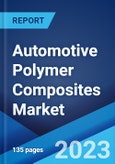Automotive polymer composites refer to a group of materials made by combining a polymer matrix with reinforcing fibers or particles. The polymer matrix can be made from a variety of materials, such as thermosetting or thermoplastic polymers, while the reinforcing fibers or particles are made from materials such as carbon fiber, glass fiber, or aramid. They exhibit improved mechanical properties such as high strength-to-weight ratio, stiffness, and toughness compared to the polymer matrix alone. They also have good fatigue resistance, corrosion resistance, and thermal stability. In the automotive industry, these composites are used to replace traditional materials such as steel or aluminum in various applications, such as body panels, structural components, and interior parts. This is due to the lightweight, high-strength properties of the composites, which can help reduce vehicle weight, improve fuel efficiency, and meet safety and performance requirements. Owing to these properties, automotive polymer composites are widely utilized in the automotive industry across the globe.
Automotive Polymer Composites Market Trends:
The market is primarily driven by the escalating demand for lightweight vehicles across the globe. The automotive industry is increasingly focused on reducing the weight of vehicles to improve fuel efficiency and reduce emissions. Polymer composites are lighter than traditional materials such as steel or aluminum, making them an attractive option for automakers. In addition, various technological advancements in the manufacturing process of these materials represent another major growth-inducing factor, as the cost of producing polymer composites has decreased over the years, making them more cost-effective compared to traditional materials. Besides this, governments of numerous countries are imposing more stringent emissions and fuel efficiency regulations on automakers, which is driving the adoption of lightweight materials such as polymer composites. This, coupled with the increasing adoption of eco-friendly materials in the automotive industry that involve less energy and fewer greenhouse gas emissions during production, is positively influencing the market growth. Furthermore, the growing consumer preferences toward electric cars, various competitive strategies adopted by key players such as capacity expansion, partnerships, and mergers and acquisitions (M&As), and various benefits provided by polymer composites such as design flexibility and corrosion resistance are some of the other factors creating a favorable market outlook across the globe.Key Market Segmentation:
The publisher provides an analysis of the key trends in each segment of the global automotive polymer composites market, along with forecasts at the global, regional, and country levels from 2025-2033. Our report has categorized the market based on resin type, product, manufacturing process, application, and end use.Resin Type Insights:
- Epoxy
- Polyurethane
- Polyamide
- Polypropylene
- Polyethylene
- Polyester
- Vinyl Ester
- Others
Product Insights:
- Glass Fiber Composites
- Natural Fiber Composites
- Carbon Fiber Composites
Manufacturing Process Insights:
- Compression Molding
- Injection Molding
- Resin Transfer Molding
- Sheet Molding
Application Insights:
- Interior Components
- Exterior Components
- Structural Components
- Powertrain Components
End Use Insights:
- Conventional Vehicles
- Electric Vehicles
- Trucks and Buses
Regional Insights:
- North America
- United States
- Canada
- Europe
- Germany
- France
- United Kingdom
- Italy
- Spain
- Russia
- Others
- Asia Pacific
- China
- Japan
- India
- South Korea
- Australia
- Indonesia
- Others
- Latin America
- Brazil
- Mexico
- Others
- Middle East and Africa
Competitive Landscape:
The report has also provided a comprehensive analysis of the competitive landscape in the global automotive polymer composites market. Detailed profiles of all major companies have also been provided. Some of the companies covered include BASF SE, Covestro AG, DuPont de Nemours Inc., SGL Carbon SE, Teijin Carbon Europe GmbH (Teijin Limited), Toray Advanced Composites, etc. Kindly note that this only represents a partial list of companies, and the complete list has been provided in the report.Key Questions Answered in This Report:
- How has the global automotive polymer composites market performed so far, and how will it perform in the coming years ?
- What are the drivers, restraints, and opportunities in the global automotive polymer composites market ?
- What is the impact of each driver, restraint, and opportunity on the global automotive polymer composites market ?
- What are the key regional markets ?
- Which countries represent the most attractive automotive polymer composites market ?
- What is the breakup of the market based on the resin type ?
- Which is the most attractive resin type in the automotive polymer composites market ?
- What is the breakup of the market based on the product ?
- Which is the most attractive product in the automotive polymer composites market ?
- What is the breakup of the market based on manufacturing process ?
- Which is the most attractive manufacturing process in the automotive polymer composites market ?
- What is the breakup of the market based on application ?
- Which is the most attractive application in the automotive polymer composites market ?
- What is the breakup of the market based on end use ?
- Which is the most attractive end use in the automotive polymer composites market ?
- What is the competitive structure of the global automotive polymer composites market ?
- Who are the key players/companies in the global automotive polymer composites market ?
Table of Contents
Companies Mentioned
- BASF SE
- Covestro AG
- DuPont de Nemours Inc.
- SGL Carbon SE
- Teijin Carbon Europe GmbH (Teijin Limited)
- Toray Advanced Composites
Table Information
| Report Attribute | Details |
|---|---|
| No. of Pages | 144 |
| Published | March 2025 |
| Forecast Period | 2024 - 2033 |
| Estimated Market Value ( USD | $ 10 Billion |
| Forecasted Market Value ( USD | $ 17.3 Billion |
| Compound Annual Growth Rate | 6.3% |
| Regions Covered | Global |
| No. of Companies Mentioned | 6 |









